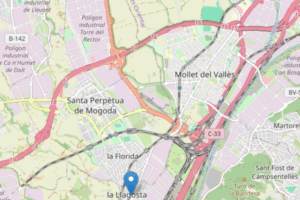
Improved efficiency in pest control through photonic technology
February 16, 2021
Coppereplace: reduce the application of copper to vineyards and its environmental impact
February 22, 2021The UPC Centre for Technological Innovation in Static Converters and Drives (CITCEA) has worked on the international project Renewable penetration levered by Efficient Low Voltage Distribution grids (RESOLVD) to create a device that manages flows of electrical energy that are generated between solar panels, consumption and the set of converters and batteries, to make them more efficient and environmentally friendly.
The equipment has been developed as part of the European project RESOLVD, which is coordinated by the Control Engineering and Intelligent Systems (eXiT) research group, integrated into the Institute of Informatics and Applications of the University of Girona (UdG). Partners in the project are from five European countries: CITCEA, the electrical energy distributor Estabanell Distribució, the research centre Joanneum Research (Austria), the company in the ICT sector Intracom Telecom (Greece), the company Comsensus (Slovenia) and the innovation centre Smart Innovation Norway (Norway). The project has taken three and a half years and has been financed with European Commission funds, as part of the Horizon 2020 programme.
The aim of RESOLVD has been to advance in the management of the low voltage grid and energy flows. CITCEA has developed the Power Electronic Device (PED) that can be used to manage various storage technologies with just one piece of equipment based on advanced power electronics. The new device is strategically connected to the grid and can be used to manage flows of electrical energy that are generated between solar panels, the consumption and the set of converters and batteries, to make them more efficient and environmentally friendly.

Better advantage can be taken of energy that is generated locally, due to the capacity to store the surplus production and release it when it is needed, depending on the management systems in the area and taking advantage of peaks in photovoltaic generation.
Estabanell has led the integration of all physical components and the technology. This has been validated in a pilot study in the Municipality of Esquirol (Osona), within the Estabanell low voltage grid, which is the section of the grid that connects houses and businesses to the electricity supply. Specifically, the system validated how to manage renewable photovoltaic sources and electric mobility with user consumption.
In addition to coordinating the project, the task of the eXIT group has been focused on developing algorithms to predict the daily demand and energy generation and the subsequent planning of charging and discharging of batteries. These data can be analysed to predict problems of congestion in the grid or variation in voltage that could affect the quality of supply to the consumer.
Related news: RESOLVD: Improve the efficiency of grids
Technology
You want to know more?
Related Projects
- The company Trace ID and the group Twin Investors, in collaboration with the Textile Technology research group (TECTEX), which is part of the Institute of Textile Research and Industrial Cooperation of Terrassa (INTEXTER) at the Universitat Politècnica de Catalunya - BarcelonaTech (UPC), are developing electronic devices to identify, monitor, and study the traceability of the products in which they are embedded.
- The Hydrogeology Group (GHS) at the Universitat Politècnica de Catalunya - BarcelonaTech (UPC) is participating in the LIFE REMAR project to develop an innovative and sustainable solution for the reuse of treated wastewater through infiltration, with the aim of increasing the availability of freshwater resources and improving the state of ecosystems.
- A team from the Environment Centre Laboratory (LCMA) of the Universitat Politècnica de Catalunya - BarcelonaTech (UPC) is taking part in a study commissioned by the city councils of la Llagosta, Mollet and Santa Perpètua (in Vallès Occidental), with the main objective of identifying the impact of industrial plants on the generation of unpleasant odours and continuously monitoring air quality in these municipalities.
- A multidisciplinary team of researchers from the Research Group in Smart and Sustainable Resources and Industries (RIIS), the Sustainable Mining Research Group (GREMS), and the Construction Materials and Roads (MATCAR) group at the Universitat Politècnica de Catalunya – BarcelonaTech (UPC) is leading the VALORFIN project. The aim is to develop a technological solution for the valorisation of the fine fraction of construction and demolition waste (CDW), transforming it into new low-CO₂-emission cementitious materials, while also reducing the presence of hazardous materials in this waste.




